CHARLOTTE, N.C. — Ford is quick to point out that the Dark Horse is a brand-new model for the Mustang lineup, and not a direct successor to cars like the Boss 302, Bullitt, Mach 1 or Shelby GT350. It’s “the horse you didn’t see coming,” according to one executive. But after spending time with the 2024 Ford Mustang Dark Horse on road and track in North Carolina, boy, this one sure feels familiar.
The Dark Horse builds off the new Mustang GT we've already reviewed, and it uses the same naturally aspirated 5.0-liter V8 engine, albeit with some meaningful changes. Stronger camshafts, a balanced crankshaft and forged connecting rods make the Coyote V8 engine better able to withstand track abuse, and a dual throttle-body intake and larger nostrils in the grille improve airflow. Combined with a small ECU tweak, the Dark Horse puts out 500 horsepower at 7,250 rpm and 418 pound-feet of torque at 4,900 rpm.
Compared to a Mustang GT with the optional active-valve exhaust, the Dark Horse is up 14 hp, but has an identical amount of torque. Yet under hard acceleration, the Dark Horse does feel quicker. The big V8 is better able to suck in cool air, making the 5.0-liter engine more eager to rev to its 7,500-rpm redline. Ford doesn’t have any official 0-to-60-mph acceleration times, but from behind the wheel, I promise, the Dark Horse is a bit more alive.
Of course, a lot of that visceral sense of speed could come down to the more pronounced exhaust note, bellowing out from dark-finished quad tips. This car sounds great; 10 out of 10, no notes. I could listen to it rev to its redline ceiling all day long and never get bored.

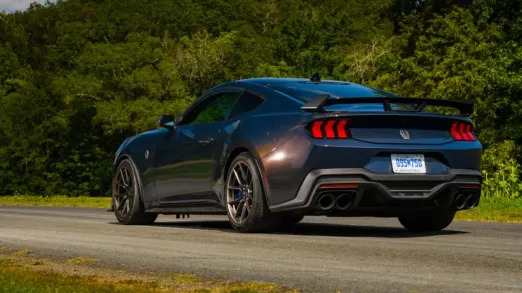
Ford offers the Mustang Dark Horse with a quick-shifting 10-speed automatic transmission, but please, get the six-speed manual instead. This isn’t a carryover gearbox from the Mustang GT; it’s the Tremec TR-3160 transmission you might remember from the Shelby GT350, and my goodness, it’s a peach. Not only is the clutch the right amount of heavy with a clearly communicated take-up point, the action of the shifter itself is tactile satisfaction to the max. Special props go to the 3D-printed titanium shift knob, which is perfectly sized and cool to the touch. It’s an experience you won’t come close to matching with the 10-speed auto’s crap-tastic plastic paddles.
The manual transmission has the same driver aids you’ll find in the Mustang GT, meaning there’s no-lift upshifting, which is great for hard launches, and automatic rev-matching downshifts. Yes, you can turn the latter off if you want, but I love leaving it on. This makes the Mustang a lot smoother to drive in the city when you’re stuck in crummy traffic, and the downshifting logic is super smart, so you’ll be in the heart of a lower gear sooner than if you were to heel-and-toe on your own.
Beefier front shocks and a new rear sway bar set the Dark Horse's chassis apart from the lesser Mustang GT, along with the standard fitment of Ford's excellent MagneRide adaptive dampers. That said, the ride quality is definitely stiff, even when you’re driving in the standard (“Normal”) driving mode. Along North Carolina’s country backroads, the MagneRide suspension does a nice job of keeping the Dark Horse stable and planted, but you really do feel every little imperfection. At least this thing doesn’t tramline like crazy, à la the Shelby GT350.
The standard 19-inch wheels are staggered in width, measuring 9.5 inches up front and 10.0 inches around back. These wheels come wrapped in Pirelli P Zero summer tires, behind which you'll find six-piston front Brembo brakes with 15.3-inch rotors, and four-piston rear stoppers with 13.9-inch rotors. These brakes are fantastic, and better able to resist fade. Oh, and speaking of brakes, the very cool Drift Brake from other Mustang models is optional on the Dark Horse, if you're keen to get your slide on.
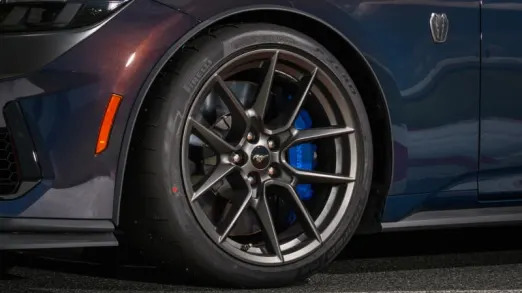
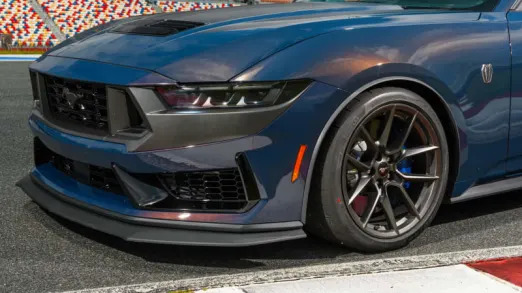
In its standard configuration, the Dark Horse is fun to drive, yet imperfect. Like the other 2024 Mustangs, the steering needs work. It’s too light and numb on center, and it feels overboosted on turn-in. Yes, the Dark Horse responds quickly to inputs, but there’s no sense of communication between the steering wheel and the tires, and that’s true regardless of driving mode.
Spring for the Dark Horse’s $4,995 Handling Package and the steering is a little better, mostly thanks to the wider contact patches of the 10.5-inch front and 11.0-inch rear Pirelli Trofeo R tires. This package also adds stiffer springs and larger sway bars, along with a unique rear spoiler that has an integrated Gurney flap. It’s a worthwhile addition if you plan on tracking the Dark Horse. Those fancy-shmancy carbon fiber wheels are still in the cards, by the way, but aren’t available just yet.
Around a roval course at Charlotte Motor Speedway, the Dark Horse can really strut its stuff. The stiffer chassis, MagneRide shocks and wider tires certainly help this Mustang cut a rug, but once again, the steering is a real let-down. Outward visibility sucks, too, especially with a helmet on, due to the Mustang’s high beltline, tall dash screens and generally dark and cramped cabin.

On that note, while the new Mustang’s interior will initially impress you with its wide screens and great list of tech, closer inspection reveals a number of cheap materials and generally drab accommodations. It’s the little things, like window controls that are too far away, even for someone like me with short legs who sits closer to the steering wheel than most. Or notice how the row of buttons to the right of the bright red engine start button is actually one solid piece of plastic, so the whole thing moves no matter which icon you push. I could even push the blank far-left ‘button’ on my test car. The wireless charging pad cover easily pops off, too.
The optional Recaro seats are a worthwhile upgrade, with all-day comfort and generous bolstering, but they don’t up the interior’s luxe factor at all. They also don’t adjust as much and make it harder to access the back seats, not that you’ll be using those for passengers on the regular. At least, I hope not.
But hey, screens! Big screens! A single housing encompasses a 12.4-inch digital gauge cluster and 13.2-inch central multimedia display, both of which quickly respond to inputs thanks to strong processing power. Apple CarPlay and Android Auto connect wirelessly if you’d prefer to go that route, and I like all of the different gauge designs – especially the throwback Fox Body layout (pictured below in a GT). I just wish the climate control functions at the bottom of the display weren’t so inane, with the need to tap multiple times just to adjust fan speed.
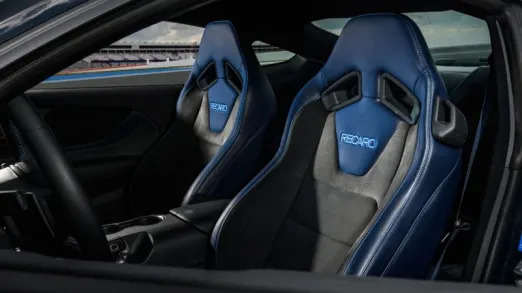



Styling is subjective, so I’ll let you decide how you feel about the Dark Horse’s overall design. Me? I’m torn. I think the seventh-generation Mustang as a whole is a step in the wrong direction, especially the crunched-in taillights and cheap-looking spoiler. The black panels under the headlights are a poor styling choice, even if they help the light housings flow into the grille. It’s even worse with brighter colors. Who knew there was a way to make Grabber Blue look bad?
The least-expensive version of the 2024 Mustang Dark Horse costs $60,865, including a mandatory $1,595 destination fee. The slightly nicer Dark Horse Premium requires an additional $3,995, but really only gets you some leather-wrapped interior bits, none of which feel particularly high quality.
Enticing as the Dark Horse seems on paper, I can’t help but feel about this car the same way I felt about the last-generation Mustang Mach 1. I’m not sure that the Dark Horse experience is really so much better than a loaded Mustang GT with the Performance Pack that it works out to be a worthwhile upgrade, especially considering it’d be rougher to drive every day. At the same time, the Dark Horse doesn’t have that special somethin’-somethin’ like a purpose-built Shelby GT350 to make it feel like a drastically different car. It’s like a Mustang GT Plus.
Think about it: The GT Performance pack includes a 3.73 rear axle, Brembo brakes, Torsen limited-slip differential and 19-inch wheels – all things that come on the Dark Horse. You can also spec a GT with the MagneRide dampers, Recaro seats and active exhaust, and still come in a few thousand bucks less than the base Dark Horse. Really, you’re just missing stiffer springs, 14 horses and the Tremec trans. That’s not nothin’, but it’s a comparison to consider, for sure.
The Dark Horse might seem new and exciting and all sorts of spooky and ethereal, but it’s really just a new spin on an older formula. The Mach 1 was a way for Ford to bridge the gap between GT and GT500 after the Shelby GT350 went away (and to a lesser extent, the Bullitt). The Dark Horse is the top dog of the Mustang range right now, but depending on what else Ford has in store for its seventh-generation pony car, it likely won’t be that way for long.










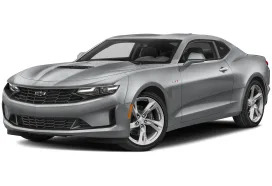
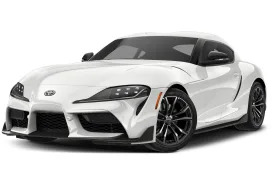

Sign in to post
Please sign in to leave a comment.
Continue